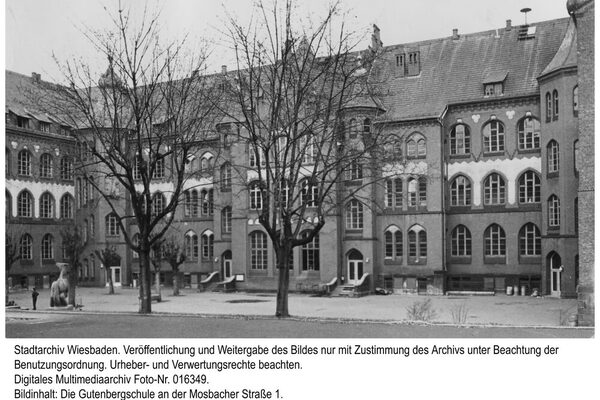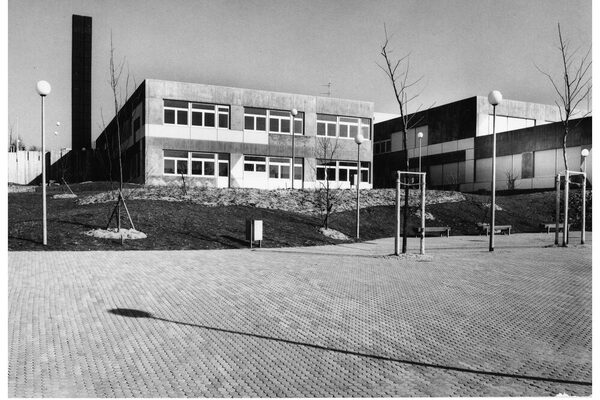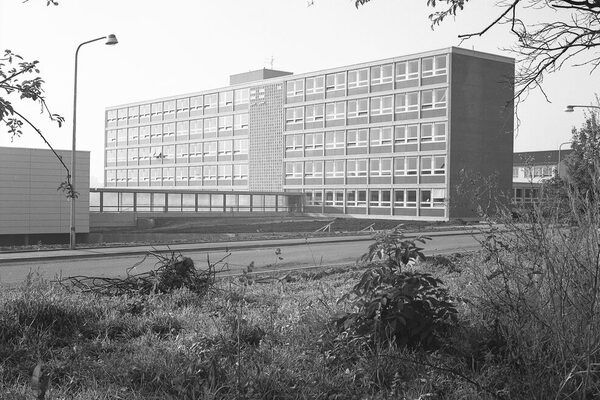Grammar schools and upper secondary schools
The oldest grammar school in Wiesbaden, today's Diltheyschule, emerged in 1844 from the Pädagogium am Luisenplatz, which was extended by a grammar school on the basis of a ducal edict and henceforth called the "Herzogliches", and from 1866 the "Königliches Gymnasium". Wilhelm Heinrich von Riehl, Wilhelm Dilthey and Ludwig Beck were important pupils. Renamed the "Staatliches Gymnasium" after the First World War and run under the same management as the Realgymnasium in 1932, the dual institution had to move into the building originally designed for the Gutenberg elementary school on Gutenbergplatz in 1934, operated as the "Oberschule mit Gymnasium" from 1936 and was called the "Diltheyschule" from 1951. The old language branch took this name with it when it was moved to Alexandrastraße in 1955. In 1962, the school moved to the new building on Mosbacher Berg and also accepted girls for the first time. Growing pupil numbers led to another change of location: in 1969, the old language branch moved to its current location in Georg-August-Straße, but was soon expanded again to include a new language branch. The former modern language section remained in Mosbacher Straße as "Gymnasium am Mosbacher Berg". In the 1980s, this school was repeatedly discussed for closure. However, the general refurbishment in the 1990s stabilized it noticeably. Today it is a five-form grammar school.
The edict of 1844 established the only Realgymnasium in the Duchy of Nassau until then, today's Gutenbergschule. The Realschule served as the substructure. In 1932, the Realgymnasium was merged with the former "Königliches", now "Staatliches Gymnasium". When the old language section became independent as the "Diltheyschule" in 1955, the new language section in Mosbacher Straße was given the name "Gutenbergschule." The school admitted its first girls in the 1955/56 school year and officially adopted coeducation in 1968/69.
The predecessor of the Oranienschule was the "Höhere Bürgerschule für Jungen", founded in 1857 with English and French as foreign languages. It was formed from the four lower secondary school classes of the "Herzoglich Nassauisches Realgymnasium" and the preparatory class of the secondary school of the "Schule am Markt". It moved into its new building on Oranienstraße on 04.05.1868. In 1879 it was recognized as a seven-year secondary school of the second order, and in 1892 it became an upper secondary school, leading to the Abitur after nine years without Latin. In 1905, three classes were handed over as the basis for the "Städtische Oberrealschule am Zietenring" and the school on Oranienstraße was developed into a reform grammar school with a Realschule. Foreign languages were French, Latin and English. From 1911 it was known as the "Städtisches Realgymnasium mit Realschule". Relocated to the Oberrealschule on Zietenring during the First World War, the school was later able to return to its old location, but also housed the Gutenberg elementary school. Renamed the "Reformrealgymnasium" in 1931, it became the "Oberschule für Jungen an der Oranienstraße" in 1938. One of its most prominent teachers was Hermann Kaiser, a member of the resistance against Hitler. On December 1, 1945, the constitutional advisory assembly of Greater Hesse held its constituent meeting in the school's auditorium. Since 1956, the school has been named after the liberator of the Netherlands, William of Orange, and since the admission of girls in the 1976/77 school year, "Oranienschule Gymnasium für Jungen und Mädchen, Wiesbaden".
The "Städtische Oberrealschule am Zietenring", Leibnizschule since 1956, was founded in 1905. The foundation was formed by three classes from the Oberrealschule in Oranienstraße. In 1932-50 it was merged with the Riehlschule in Biebrich, although the school sections remained independent at times. The name changed several times, with Ludwig Karst taking over as headmaster in 1928. The National Socialist school reform led to the school being renamed "Riehlschule, Städtische Oberschule für Jungen am Zietenring" in 1938. When classes resumed in October 1945, the school was renamed "Riehlschule. Realgymnasium am Zietenring" and was finally renamed "Leibnizschule" in 1956 after the Biebrich local council succeeded in having the name "Riehlschule" returned to Biebrich in 1950. In 1951, the school became the first grammar school in Wiesbaden to not only admit girls, but also to teach them co-educationally. In 2001, Leibnizschule was the only grammar school in Wiesbaden to introduce a G8 stream.
The Elly Heuss School, founded in 1907 as the "Schule am Boseplatz" - since 1911 "Lyzeum II" - became the "old-style upper lyceum" in 1911, when the seminary class and the seminary training school, where prospective female teachers received academic and practical training, moved in. The Nazi school reform led to a combination of the Oberlyzeum and the women's school as the "Oberschule für Mädchen am Boseplatz". During the Second World War, some classes were moved to Schlossplatz, while the "domestic science form" was moved to the household and vocational school on Bleichstraße until 1940. At the end of 1945, the occupying power gradually released the school for teaching, and in 1951 the school was given the right to offer a social science branch starting in year 7 (Quarta), which led to the full Abitur. With the admission and co-educational schooling of boys, the Elly Heuss School dropped the addition "Gymnasium für Mädchen" (grammar school for girls) from its name in 1966 and took over the pupils and teaching staff of the Gerhart-Hauptmann-Gymnasium at the beginning of the 2005/06 school year.
The Theodor-Fliedner-Schule, founded in 1965 as a Hauptschule and Realschule, added a grammar school class at the beginning of the 1970/71 school year and thus became an additive (later: cooperative) comprehensive school. Since 2009, it has been successively expanded into a full grammar school.
Founded in 1974, the upper secondary school at Moltkering was primarily created by separating the upper secondary school from the Helene Lange School and has been known as the "Martin Niemöller School" since 1987. On the night of December 23/24, 2007, the school was completely damaged by arson and classes were moved to the Rotaprint building on Homburger Straße, which was converted at short notice, and back to the building on Bierstadter Straße in the 2011/12 school year. At the start of the 2015/16 school year, the school took on fifth classes for the first time, meaning that it is on its way to becoming a full grammar school.
Founded in 1977 as "Oberstufengymnasium West", the Carl-von-Ossietzky-Schule initially began teaching in the Kohlheckschule. With the completion of the first construction phase on Ernst-von-Harnack-Straße, the school moved there in 1979 and was named after the journalist and resistance fighter Carl-von-Ossietzky in 1989. In 2012, the school was in danger of being closed, but this was averted. A new school is due to be built at the same location due to structural defects. In the grammar school sector, the Abendgymnasium (since 1966) and the Hessenkolleg (founded in 1959) offer adults the opportunity to obtain a school-leaving qualification. Both schools work closely together and are under one management. The Abendgymnasium is housed in the Friedrich-List-Schule, while the Hessenkolleg has its own building in Alexandrastraße.
The list of grammar schools in Wiesbaden would not be complete without those secondary schools that no longer exist in this form today: The Helene Lange School emerged from the "Höhere Töchterschule". After this later Schlossplatzschule (also known as Lyzeum I) was destroyed by a bombing raid in 1945, classes were moved to Lyzeum II on Boseplatz. In 1955, the grammar school for girls was able to move into its new building on Langenbeckplatz as the "Helene-Lange-Schule". In 1971, the school accepted boys for the first time, but lost its upper secondary school to the newly founded upper secondary school at Moltkering in 1974 and was converted into an integrated comprehensive school in 1986.
The Wilhelm-Heinrich-von-Riehl-Schule was opened in Biebrich in 1847 as a Realschule, developed into a Realprogymnasium in 1893 and was renamed "Realschule mit Reform-Realprogymnasium" in 1906. After moving into the building on Rudolf-Dyckerhoff-Straße and being renamed "Riehlschule", it was granted the right to hold Abitur examinations in 1914 and became a Reformgymnasium and Oberrealschule in 1920. After the incorporation of Biebrich in 1926, the upper school was gradually relocated to Zietenring from 1931. The Dyckerhoff-Straße site was retained until 1937/1938. The era of the Biebrich grammar school came to an end with the establishment of a secondary school. The name "Riehlschule" reverted to Biebrich in 1950 at the instigation of the Biebrich local council.
The later Gerhart-Hauptmann-Gymnasium was initially a branch of the Oranienschule in 1967. The pupils were housed in the same building as the Gerhart-Hauptmann-Realschule on Manteuffelstraße. In 1968, this became the Gerhart-Hauptmann-Gymnasium, founded by the school board as a middle school (grades 5-10). The school struggled to establish a sixth form, but only one graduating class was able to complete their schooling there in 1974. After the establishment of the Oberstufengymnasium West (today: Carl-von-Ossietzky-Schule), the school, which meanwhile taught almost 1,000 pupils, became part of the school association of this Oberstufengymnasium at the beginning of the 1977/78 school year. At the end of the 2004/2005 school year, the school was officially closed and affiliated to the Elly Heuss School. For space reasons, some classes were still taught in the building on Manteuffelstraße until May 2006.
Literature
Information from the former deputy principal of Gerhart-Hauptmann Gymnasium, Rüdiger Schmidt, 29.01.2015; Supplement Wiesbadener Kurier and Wiesbadener Tagblatt on school choice 2014 (26.11.2013).
Carl von Ossietzky School Wiesbaden 1977-2002.
Elly Heuss School 1907-1982. Commemorative publication for the 75th anniversary, Wiesbaden 1982.
Commemorative publication on the 25th anniversary of the Martin-Niemöller-Schule.
Theodor-Fliedner-Schule, comprehensive school of the state capital Wiesbaden in Wiesbaden-Bierstadt - a documentation for the years 1965-1985, 1985.
Wilhelm-Heinrich-von-Riehl-School 1910-1985, 1985.
25 years Wilhelm-Leuschner-School, 20 years IGS, 1989.
100 years of the Elly Heuss School - commemorative publication for the school anniversary, Wiesbaden 2007.
100 years of Leibniz School - commemorative publication for the 100th anniversary, 2005.
125 years of Oranienschule Wiesbaden grammar school [1982] and 1957 and 2007.
150 years of Gutenbergschule Wiesbaden Grammar School 1845-1994, 1995.
160 years of Diltheyschule. Old and new language grammar school 1844-2004, 2004.
Commemorative publications Diltheyschule Wiesbaden 1977, 1983, 1994.
Festschrift Kastellstraßenschule 1984.
Festschrift Philipp-Reis-Schule 2004.
Struck, Wolf-Heino: Wiesbaden as the state capital of Nassau. Part II: Wiesbaden in the Biedermeier period (1818-1866), Wiesbaden 1981 (Geschichte der Stadt Wiesbaden Bd. 5).




